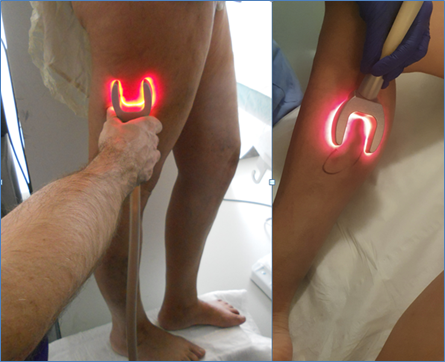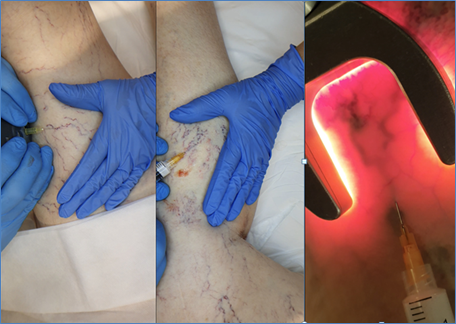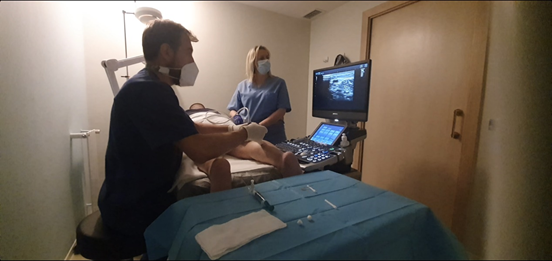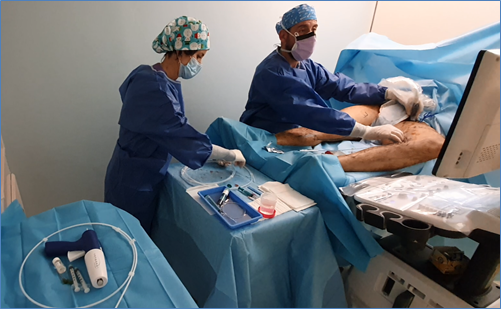Journal of
eISSN: 2373-4396


Research Article Volume 17 Issue 1
1Registered nurse, Dr. Arranz Vascular Surgery Clinic, Logroño (La Rioja), Spain
2Technician in Auxiliary Care Nursing, Dr Arranz Vascular Surgery Clinic, Spain
3Medical Director Dr. Arranz Vascular Surgery Clinic, Specialist in Angiology, Vascular Surgery and Phlebology, Spain
44 Nurse, Dr. Arranz Vascular Surgery Clinic, Spain
Correspondence: Miguel Angel Gonzalez Arranz, ID 16571665 G, Medical Specialist in Angiology and Vascular Surgery, Clinical Director of Vascular Surgery Dr Arranz. Logroño, C/ Miguel Villanueva n.8, 1º D. Logroño, Spain
Received: February 02, 2024 | Published: February 28, 2024
Citation: Santamaría C, Sara CAT, Ángel GAM. Role of the nurse in the phlebology consultation. J Cardiol Curr Res. 2024;17(1):10-14. DOI: 10.15406/jccr.2024.17.00598
Role of the nurse in the phlebology consultation
The evolution of medicine in recent years and the development of the different specialties require greater training and specialized training in nursing work.
The characteristics of the work that a private consultation presents with the specialty of Angiology and vascular Surgery in the development of phlebology, which is the area that includes the study and treatment of venous diseases, requires the nurse to prepare and train specific the techniques and procedures that are not common in the devolpment in the field hospital nursing.
We present in this paper, the work characteristics, the functions, attributions and different responsibilities that a nurse has in the Phlebology consultation within the Specialty of Angiology and vascular Surgery.
Keywords: phlebology, angiology, vascular surgery, echo doppler
The evolution of medicine in recent years and the development of different specialties require greater training and specialized training in nursing work.
The characteristics of the work presented by a private practice within the specialty of Angiology and Vascular Surgery in the development of phlebology (an area that includes the study and treatment of venous diseases), requires the nurse to undergo preparation and training in Specific techniques and procedures that are not common in the field of hospital nursing.
In this article, we present the work characteristics, functions, powers and different responsibilities that a nurse has in the phlebology consultation within the Specialty of Angiology and Vascular Surgery.
Introduction to phlebology
Phlebology is the area of the Specialty in Angiology and Vascular Surgery (SEACV / CEFyL)1 that is responsible for the study and treatment of venous diseases. The rise of concern for aesthetics as well as the increase in life expectancy in our population, means that there is a great demand for phlebological consultations, encompassing pathologies as varied as spider veins, varicose veins and their complications or ulcers and thromboses. Pathologies that range from a purely aesthetic component to serious pathologies with potential mortality such as Thromboembolic Disease.
This variability of diseases implies that the patients who request our services range from young women with primarily aesthetic concerns, who require support, trust, and security from the nurse, to elderly people with mobility deficits, who will require our help and attention both during the examination moments and during treatments, which are often painful or complex.2
The phlebological diagnosis is based on the venous DOPPLER ECHO study, which is practically essential (Figure 1). The study is carried out by the doctor and the nurse's main function is focused on supporting the patient during the test. Providing a pleasant room, with a warm temperature to avoid venous vasoconstriction, a dim light that facilitates the vision of the ultrasound machines and the maintenance of antiseptic measures, increased in this post-pandemic pandemic period, are basic but essential maneuvers during the examination.3
Sometimes phlebological ultrasound can include studies using transvaginal ultrasound, so accompanying the doctor at all times during the examination has special relevance both for the comfort of the patients and from the medical-legal point of view for the doctor.
Other tests that will complete the phlebological study will be transillumination, (Figure 2) Doppler pressure studies, or less frequent tests with the measurement of transcutaneous oximetries, in which the preparation of the electrodes and the computer software will force us to a specific knowledge of all these techniques and devices, for their correct handling and maintenance.

Figure 2 Exploration with transillumination . Suitable for visualization of reticular veins and telangiectasias subdermal.
Treatments in phlebology are distinguished by their great variability. Sclerotherapy treatments in its different modalities, varicose vein treatments using sclerosis techniques, cryosclerosis or foam sclerotherapy, (Figure 3) are common and very frequent in the treatment of pathologies with a more aesthetic component, such as spider veins or telangiectasias.

Figure 3 Cryosclerosis technique. Puncture with microfoam technique. Puncture with the help of transillumination.
In addition to sclerotherapy, in the phlebology consultation, much more complex treatments are performed on Chronic Venous Insufficiency with intravenous techniques such as Radiofrequency, endoLaser (EVLA), treatments with Cyanoacrylates (Vaseal, Venex), which can be performed in the clean or phlebological room and will require a Nurse with knowledge of surgical technique, management of intravenous drugs or sterility or surgical techniques.
Phlebology consultations, so knowing wound healing techniques, vascular bandages, and placing compression stockings become essential.4-6
Development of techniques
Generally speaking, the nurse's role has three levels in the Vascular Surgery consultation.
First level: Is concerned with patient care and preparation of consultations. Although it is not a specifically nursing task, it is common for these consultations to be held between a doctor and a nurse, and sometimes a nursing assistant, so we will lack reception, telephone operator or administrative staff.
As these are private consultations of one-person doctors, normally the first function will be to prepare the consultation lists that the doctor requires. The preparation of these lists involves receiving calls and answering appointment requests by telephone. In most cases, assistance is not limited to a single call but rather to clarifying doubts about the different diseases and treatments offered in the consultation, which implies knowing in detail the different treatment possibilities that patients may require. patients. Clarifying their doubts and being able to guide the consultation will be the patient's first contact with the consultation, so our treatment, knowledge of the pathologies and kindness becomes essential.
The assembly and organization of the appointment agendas will be completely linked to the needs that the doctor requests of us. We must anticipate that many patients will have repeated appointments to complete the different treatment sessions they require, and that on many occasions we must leave time for emergencies or preferential appointments that will arise over the months.
A function outside of direct patient care will be the control of the office's warehouses and pharmacy. A private practice is still a miniature Hospital, and the need for consumables, preparation of patients and visits, as well as the drugs used is the same, with a difference in the quantities. Managing suppliers of medicines, assistance materials or hygiene is necessary to be able to have them available when needed in the development of medical care. Furthermore, in centers that perform treatments in a clean room, it will be necessary to provide surgical material, material sterilizers, aseptic surgical fields, or the different consumable material required for the development of the different medical-surgical techniques that the physician performs in consultation.
Second level: Assistance in the consultation room. Preparation of patients for examination and preparation of documentation.
All patients who come for consultation will have a first evaluation with the vascular surgery specialist. In most cases, the consultation consists of an interview and detailed anamnesis, and a subsequent clinical examination with complementary tests such as the vascular DOPPLER ECHO study. The Ultrasound study is a non-invasive test, which in vascular cases is performed while the patient is standing. It is not uncommon that, due to the impression generated by the exploration of the blood system in patients, it causes fainting or small syncope. It is important that during the examination we remain next to the patient not only to assist the doctor, but also to assist the patient, being attentive to skin color and sweating to prevent possible syncope. If we notice any symptoms of instability, we will immediately act by lowering the patient from the bench and lying him down with slight elevation of the extremities. At all times the consultation must be equipped with a “stop cart” or emergency briefcase that contains material to take an airway, keep the airway open and supply oxygen with an ambu and O2 bottle. We will also have medications such as Atropine, Adrenaline and corticosteroids prepared in case the doctor considers it necessary (Figure 4).

Figure 4 Eco-guided puncture of the saphenous axis. Nurse at the patient's bedside, with access to assist both the doctor, the ultrasound operator and the patient.
In addition to clinical assistance, one of the functions during the consultation is clinical documentation. The current Data Protection Law7 requires that the possession and custody of all clinical documentation, files or Figure graphs, meet a series of conditions, which are registered in this law for their safekeeping and custody. In the same way, it will be very important that all computer media are under the protection of said law.
The storage of medical records and Figure graphic material must therefore be treated with the maximum sensitivity, prudence and professionalism possible, being aware of the importance of this section.
Third level: Specific treatments. Clean room assistance and clean room maintenance. Sclerotherapy technique. Eco-directed foam treatment technique. Complex treatment techniques using intravenous techniques. Endolaser/Cyanoacrylates.
Most of the treatments carried out in phlebology will take place in the clean or white room (cleen room) or treatment room.
A phlebological room is a room with the same characteristics as an operating room in terms of lighting and cleaning, but it lacks the pressurization and positive pressure systems typical of these. They are places that are perfectly qualified to carry out interventional procedures that are common in phlebology treatments.
Treatments in phlebology
Treatment through sclerotherapy. Sclerotherapy treatments are performed for the treatment of spider veins. There are different technical procedures such as cryosclerotherapy or normal or microfoam sclerosis. The treatments require the parenteral administration of a sclerosant, which will vary both the drug and its dose depending on the vessel treated, so close attention will have to be paid to the physician's requests, since an error in the type of drug or in the requested concentration can cause serious complications. Sometimes the treatments are carried out through cryosclerosis, for which cryo syringes are prepared that are loaded into CO2 bottles with carbon snow, achieving a temperature of -42 C. The drugs are loaded into 1ml syringes, and introduced into the inside to reach freezing temperature. The maintenance of these containers or cryo syringes is delicate and meticulous, both for their sterilization after each use, and for their preparation to accept dry ice. Sometimes drugs are also used in foam or microfoam formats that are prepared together with the doctor, immediately before the treatment due to the duration of the stability of the foam formats (few minutes), and because of the importance of dosage adequacy., which will vary in a significant percentage depending on the territory to be treated.
Foam treatment of truncal varicose veins. Truncular varicose veins are larger caliber veins than spider veins, measuring over 4 mm in diameter. Foam treatment of these, and sometimes of the Saphenous Veins, is always performed under ultrasound control and using ultrasound-guided puncture. (Figure 4)
The preparation of the foam can be done with different methods, such as the Tessari method that uses two 5 or 10 cc syringes and a three-step stopcock, using a self-prepared kit such as Ferrer's Easyfoam, in which both the air and the valve and the syringes for its preparation come pre-filled, or techniques such as the Roche foam hood. In short, different methods for preparing the foam to obtain an appropriate density for the treated glass.
The administration of the foam is always carried out under ultrasound control, so in almost all cases we will have to assist the surgeon during the execution and administration of the drug, both when it is done with a extender, or when we manipulate the ultrasound to facilitate the vision of the glass during the procedure.
-Intravenous treatments for varicose veins. Treatments for larger varicose veins, and especially when they involve the saphenous axes, are performed with more complex techniques using endoluminal treatments such as Endolaser, Radiofrequency, sealing with Cyanoacrylate, or sealing with mechanochemical methods such as Flebogrif.
Generally, techniques using thermoablative techniques (EndoLASER or Radiofrequency) are performed with anesthesia (the most common being deep sedation or spinal anesthesia) and therefore in the operating room, so they go beyond the usual use of a clean room. If we have knowledge of Instrumentation we can assist the Surgeon during interventions in the operating room.
Treatments that do not require anesthesia and are performed in a clean room are intravenous techniques using Cyanoacrylates (Venaseal, Venex...) or treatments with mechanical-chemical techniques such as Flebogrif.8
Preparation requires greater complexity than previous techniques. After removing all clothing and providing a nightgown, the patient will go to the treatment room where the doctor will first perform a preoperative ultrasound mapping. We will proceed to place the preoperative protocols that each doctor provides. In our specific case, constants are taken through basic monitoring. Exceptionally, a peripheral line is used, and it is usual to perform treatments without a venous line. (It should be noted that the catheterization of the vessel to be treated provides a venous line, which is present throughout the procedure if there is a serious complication)
After the ultrasound, the patient lies on the stretcher and a surgical field is set up in sterile conditions, between the doctor and the nurse. Let's prepare the sterile material table with the help of our nursing assistant, who requires the different consumables and cyanoacrylate treatment catheters, and the introducers for vein puncture. In the same way, the ultrasound machine is dressed so that it enters the surgical field in sterile conditions. Once the surgeon catheterizes the saphenous vein to be treated under ultrasound-guided puncture, the different treatment catheters will be exchanged, until the administration of cyanoacrylate for the correct sealing of the vessel. As it is a painless technique, anesthetic control of the patient is not necessary since the patient will be awake at all times and will tell us about their experience and condition, of which we must be in charge since the surgeon will pay more attention to the correct development of the procedure. During the entire procedure we will be in sterile intraoperative conditions, to be able to instrument and help the surgeon correctly and with guarantees, which requires surgical and instrumentation knowledge to be able to assist with guarantees in this phase of the treatments. For the correct development of the technique we will have a third person, a nursing assistant, as a circulator and assistant for drugs and materials that may arise and are not included in the surgical field.
Once the treatment is finished, we will clean and disinfect the extremities, and we will review the entry puncture to avoid any minimal bleeding, allergic reaction or anomaly that we will detect and immediately communicate to the specialist to act as quickly as possible. (Figure 5)

Figure 5 Treatment in a phlebological room using cyanoacrylate venaseal. Assistance by scrub nurse. Conditions of the procedure with surgical sterility.
Complications in phlebology
During any type of treatment, despite their safety and the low chances of complications, you must always be alert and trained for any adversity. It is essential that we know the possible complications and the protocols for their action, which will be presented by both the consultations and centers in which we operate. We will always have a guedel cannula located, with different sizes appropriate to the patient's anatomy and the stop cart with basic life support material.
Syncope, which is perhaps the most common complication, will require baseline attention and Trendelenburg postural placement. The second most common complication is allergic reactions, the most common being local allergic reactions that only require antihistamine treatment. However, an allergic reaction through anaphylactic shock can be the most serious complications we could face. Speed of action and serenity is the key to being able to act effectively.
Having a first aid bag equipped with an ambu and an O2 bottle is mandatory in any medical center. We will have to take a route as quickly as possible, and administer the drugs that the doctor tells us. We must keep in mind that even though these complications are rare, they must be trained and carried out with a certain frequency so that they can develop, if necessary, completely normally. Knowing and reviewing the medications available in the consultation, and the location of all the material is essential, especially in the case of serious complications. (Tables 1&2)
|
CP support material |
Pharmacotherapy |
|
5 liter O2 bottle |
Adrenalin. Atropine. Prednisone. Low Weight Heparin. |
|
Oxygen facial mask |
Glucosaline serum 1000 cc |
|
Guedel tubes. |
Physiological serum 1000 |
|
Pulse oximeter. |
Abocath 16G, 18G, 21G, |
|
Ambu. |
|
Table 2 Common material in Phlebology consultation
The progression of the techniques and fields of Medical Specialties has experienced an exponential increase in the last century. The general practitioner who treated heart and lung or was dedicated to various fields of surgery has gone far. The specific technology, the complexity of diagnostic tests and machines and the increase in knowledge available in each Specialty, fully affects the Nursing profession, requiring, to the same extent as doctors, hyperspecialization, in order to offer care. quality, qualified and highly technical according to current times and needs.
Within the specialty of Angiology and Vascular Surgery, there is an area dedicated to the treatment of venous diseases called phlebology. The diagnosis and therapy of phlebology requires exhaustive knowledge of different techniques and increasingly specific and technical devices. The preparation and technical knowledge is not only limited to the theoretical knowledge of the presentation of different diseases and pathologies, but also covers a very extensive area of aesthetic phlebology, straddling the surgical, medical, and aesthetic specialties themselves and diagnostics, especially based on the management of Doppler echo. This area reaches its maximum development in private medicine, in which a personal consultation requires the nurse to have knowledge of materials, techniques, pathologies and different agenda programs for their proper organization and development.
The demand and concern of today's society for improving body image also specifically affects this area of medicine, increasingly addressing small varicose veins with little pathological impact but with important aesthetic concern. The management of these patients will require different attention from us to meet their needs and expectations, and to be able to accompany the doctor in obtaining the best results.
We cannot leave aside that medicine and nursing, in the eternal fight against disease, require specific equipment that is increasingly more complex to improve diagnoses, and facilitate increasingly less invasive and aggressive treatments. But above all, they require human material, an indispensable and essential piece so that the patient can improve their ailments, so our professional preparation and technical knowledge will be the authentic seal and guarantee of quality of the final result.
None.
None.

©2024 Santamaría, et al. This is an open access article distributed under the terms of the, which permits unrestricted use, distribution, and build upon your work non-commercially.